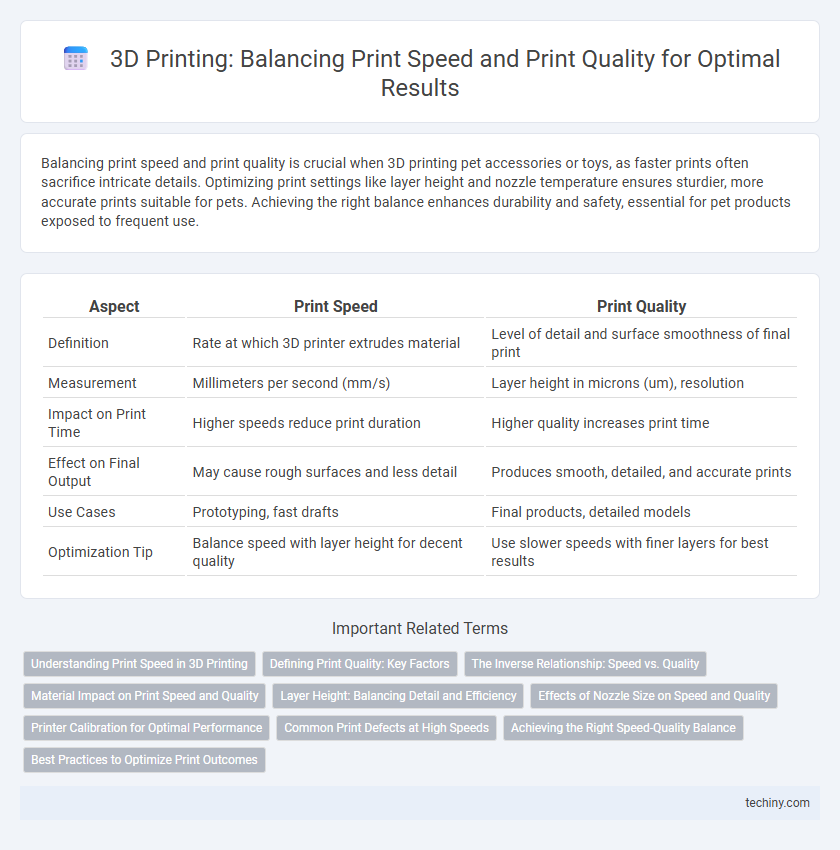Balancing print speed and print quality is crucial when 3D printing pet accessories or toys, as faster prints often sacrifice intricate details. Optimizing print settings like layer height and nozzle temperature ensures sturdier, more accurate prints suitable for pets. Achieving the right balance enhances durability and safety, essential for pet products exposed to frequent use.
Table of Comparison
| Aspect | Print Speed | Print Quality |
|---|---|---|
| Definition | Rate at which 3D printer extrudes material | Level of detail and surface smoothness of final print |
| Measurement | Millimeters per second (mm/s) | Layer height in microns (um), resolution |
| Impact on Print Time | Higher speeds reduce print duration | Higher quality increases print time |
| Effect on Final Output | May cause rough surfaces and less detail | Produces smooth, detailed, and accurate prints |
| Use Cases | Prototyping, fast drafts | Final products, detailed models |
| Optimization Tip | Balance speed with layer height for decent quality | Use slower speeds with finer layers for best results |
Understanding Print Speed in 3D Printing
Print speed in 3D printing refers to the rate at which the printer's nozzle deposits material, directly impacting the overall production time. Faster print speeds can reduce project duration but often compromise layer adhesion and surface finish, leading to lower print quality. Optimizing print speed requires balancing mechanical capabilities, filament properties, and desired resolution to achieve efficient yet precise results.
Defining Print Quality: Key Factors
Print quality in 3D printing is determined by layer resolution, surface finish, and dimensional accuracy, which affect the final object's detail and strength. Higher layer resolution reduces visible lines and enhances intricate features but often slows print speed. Optimizing print parameters like nozzle size and temperature directly influences the quality-speed balance, enabling tailored results for functional prototypes or detailed models.
The Inverse Relationship: Speed vs. Quality
Print speed and print quality in 3D printing exhibit an inverse relationship where increasing speed often compromises the final object's resolution and detail. High-speed printing can introduce layer misalignment, surface roughness, and reduced accuracy, while slower speeds allow more precise deposition and finer layer adhesion. Optimizing this balance is crucial for applications requiring detailed prototypes or functional parts with stringent dimensional tolerances.
Material Impact on Print Speed and Quality
Material selection significantly influences print speed and quality in 3D printing, with thermoplastics like PLA offering faster print times due to lower melting points and easier extrusion compared to flexible materials such as TPU, which require slower speeds to maintain detailed features. High-viscosity resins and composite filaments demand reduced print speeds to prevent defects and achieve smooth surface finishes, while standard filaments allow more aggressive speeds but may compromise intricate details. Understanding the material's thermal properties and flow behavior is crucial for optimizing print parameters that balance efficient production time and superior dimensional accuracy.
Layer Height: Balancing Detail and Efficiency
Layer height critically impacts 3D printing output, with thinner layers producing finer details by reducing visible layer lines, essential for high-resolution models in industries like jewelry and prototyping. Larger layer heights improve print speed by depositing more material per pass, benefiting functional parts where precision is less critical, such as mechanical components. Achieving an optimal balance between print speed and print quality involves selecting a layer height that meets the design's detail requirements while maximizing manufacturing efficiency.
Effects of Nozzle Size on Speed and Quality
Nozzle size significantly affects 3D printing speed and quality by controlling layer resolution and extrusion flow rate. Larger nozzles increase print speed by extruding more filament per pass, but reduce detail and surface smoothness, leading to lower resolution prints. Conversely, smaller nozzles enhance print quality with finer details and smoother finishes but slow down printing due to smaller extrusion widths.
Printer Calibration for Optimal Performance
Proper printer calibration is essential for balancing print speed and print quality in 3D printing, as precise adjustments to nozzle temperature, bed leveling, and extrusion rate directly impact layer adhesion and surface finish. Optimizing stepper motor current and belt tension reduces mechanical vibrations that can degrade print accuracy at higher speeds. Regular calibration routines help maintain dimensional accuracy and minimize defects, ensuring the printer operates efficiently without compromising detail resolution.
Common Print Defects at High Speeds
High print speeds in 3D printing often result in common defects such as layer shifting, poor layer adhesion, and surface roughness due to insufficient cooling and extrusion inconsistencies. Rapid movements can cause vibrations and misalignments, leading to dimensional inaccuracies and weakened structural integrity. Optimizing print speed balances quality by reducing defects while maintaining reasonable production times.
Achieving the Right Speed-Quality Balance
Achieving the right speed-quality balance in 3D printing requires optimizing layer height and print speed to maintain fine detail without excessive build time. Faster print speeds often reduce the resolution and surface finish quality, especially in complex geometries or intricate designs. Adjusting parameters such as nozzle temperature and cooling can help stabilize print quality while increasing throughput on printers like FDM or SLA systems.
Best Practices to Optimize Print Outcomes
Optimizing print outcomes in 3D printing requires balancing print speed with print quality by fine-tuning layer height, print temperature, and nozzle speed. Slower print speeds typically enhance detail resolution and layer adhesion, while faster speeds may cause defects like stringing and poor surface finish. Employing slicer settings such as adaptive layer height and adjusting print acceleration can maximize efficiency without sacrificing quality.
Print Speed vs Print Quality Infographic

 techiny.com
techiny.com